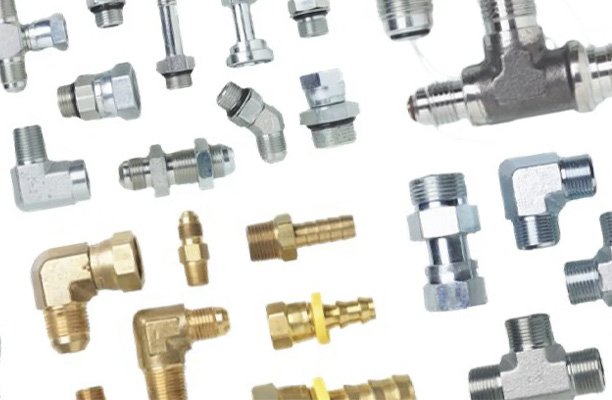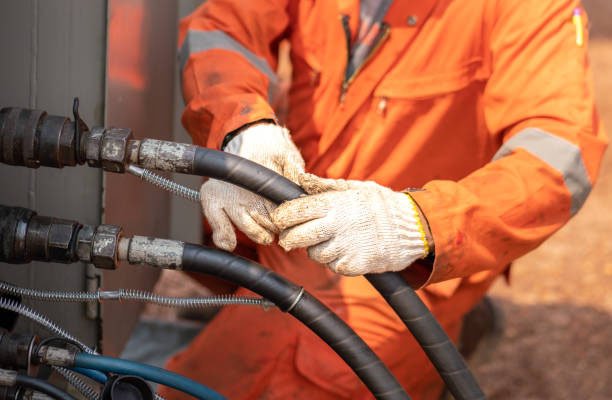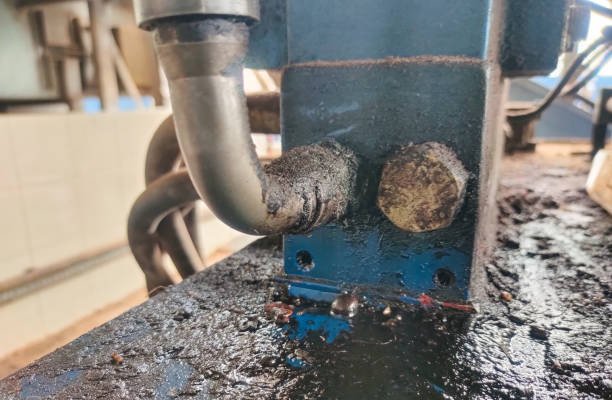Introduction to Hydraulic Fittings Maintenance
Hydraulic systems are the lifeblood of numerous industries, including manufacturing, construction, agriculture, and transportation. These systems rely on precise fluid control to power machinery and ensure operational efficiency. At the core of this functionality lies a network of hydraulic fittings, responsible for connecting hoses, pipes, and components to direct the pressurized fluid safely and effectively.
Maintaining these fittings is not merely a matter of best practice—it’s essential for ensuring system integrity, minimizing downtime, and upholding workplace safety. Faulty or poorly maintained fittings can lead to leaks, pressure loss, and catastrophic equipment failure. This article explores the critical question: When should hydraulic fittings be reinstalled or replaced? We’ll break down the indicators, best practices, and safety standards needed to make informed maintenance decisions.
Understanding Hydraulic Fittings

What Are Hydraulic Fittings?
Hydraulic fittings are components used to connect hydraulic hoses, tubes, and pipes. They enable the seamless flow of hydraulic fluid under high pressure, serving as junctions between various system components. Fittings must endure intense pressure, vibration, and environmental exposure while preventing leaks and fluid contamination.
Types of Hydraulic Fittings
- Flare fittings: Utilized in high-pressure applications, with a conical flare at the end of tubing to ensure a tight seal.
- Compression fittings: Rely on a ferrule and nut to create a sealed connection, often used in lower-pressure systems.
- O-ring face seal fittings: Offer superior leak resistance using an embedded O-ring for a flat-sealing surface.
- Pipe thread fittings: Common in older systems, they use tapered threads to achieve a mechanical seal, though prone to leakage without proper sealant.
Common Materials Used
- Carbon Steel: Durable and cost-effective, but prone to corrosion without protective coatings.
- Stainless Steel: Highly resistant to corrosion, ideal for marine or high-humidity environments.
- Brass: Good corrosion resistance and ease of installation, typically used in light-duty applications.
Common Causes of Hydraulic Fitting Failure
1. Wear and Tear from Pressure Cycles
Hydraulic fittings endure constant changes in pressure. Repeated pressure cycling causes material fatigue, loosening connections over time and potentially leading to leaks or ruptures. This is especially common in systems that operate near their maximum pressure thresholds.
2. Corrosion and Rust Accumulation
Corrosion is a leading cause of hydraulic fitting degradation. Moisture, chemical exposure, or inadequate maintenance can lead to rust and pitting, especially in carbon steel components. Even stainless steel fittings may succumb over time in aggressive environments.
3. Improper Installation and Alignment
Incorrect torque application, misaligned hoses, or using mismatched components can all compromise fitting integrity. Over-tightening may crack fittings, while under-tightening allows leakage. Alignment issues also place undue stress on fittings, increasing the risk of premature failure.
4. Vibration and Mechanical Stress
Machines operating with heavy vibration can cause fittings to loosen or crack. This is common in mobile equipment or systems with poor vibration dampening. Constant mechanical stress from misaligned hoses or pulsing fluid flow can exacerbate the issue.
Signs That Indicate Hydraulic Fittings Need Attention
1. Leaks Around Fitting Joints
One of the most obvious indicators of a faulty hydraulic fitting is a leak. Leaks may appear as slow drips or high-pressure sprays and are often visible at joint seams or connection points. If detected early, some fittings may be re-tightened or reseated; however, persistent leaks often signal deeper issues such as cracks or sealing failures.
2. Reduced System Pressure
When hydraulic pressure drops unexpectedly, it can be a sign that fittings are leaking or failing internally. A loss of pressure reduces the efficiency of hydraulic equipment and can lead to system performance issues, such as sluggish actuation or incomplete cycles.
3. Visible Cracks or Deformations
Physical damage such as cracks, bulges, or distorted shapes in the fittings indicate severe structural compromise. This may result from overtightening, excessive mechanical stress, or corrosion weakening the material. Any visually compromised fitting should be replaced immediately to avoid catastrophic failure.
4. Unusual Noises or System Vibrations
Air entering the hydraulic system through a damaged fitting may cause cavitation, often identified by whining or banging noises. Similarly, excessive vibration may point to loosened or misaligned fittings. These symptoms not only signal existing problems but also risk worsening the damage over time.
When to Reinstall Hydraulic Fittings
1. Minor Alignment Issues
If a fitting is slightly out of alignment but otherwise undamaged, simply reseating and properly securing the component may restore its functionality. Reinstallation is often the first course of action during routine inspections where fittings show no signs of fatigue or damage.
2. Fittings with No Visible Damage
Reinstallation can be appropriate when fittings are disassembled for routine system cleaning, hose replacement, or other preventative maintenance. If the fittings appear structurally sound and free of corrosion or wear, they can usually be reused.
3. Post-Maintenance Reassembly
After maintenance tasks that involve breaking the hydraulic circuit—such as flushing the system or changing valves—fittings that were removed should be cleaned, inspected, and reinstalled using proper torque and sealing methods. This reduces waste and keeps maintenance costs manageable.
4. Reinstallation Best Practices
- Clean all mating surfaces thoroughly before reassembly.
- Use manufacturer-recommended thread sealants or O-rings.
- Apply correct torque values based on fitting size and material.
- Use two wrenches: one to hold and one to tighten, avoiding hose twist.
When to Replace Hydraulic Fittings

1. Recurrent Leaks Despite Reinstallation
Persistent leaks after proper reinstallation efforts usually indicate an underlying issue such as a deformed sealing surface or micro-cracks. In such cases, replacing the fitting is the safest and most reliable solution to restore system integrity.
2. Cracked or Damaged Fittings
Any fitting with visible cracks, cross-threading, or physical deformation must be replaced immediately. Using damaged fittings can lead to catastrophic hydraulic failures, endangering equipment and personnel alike.
3. Corroded or Rusted Connectors
Corrosion compromises the material strength of fittings, potentially leading to sudden ruptures under pressure. Even minor rusting on critical sealing surfaces can cause leaks. If corrosion is found, replacing the affected fittings—and evaluating the system for contamination—is necessary.
4. Manufacturer’s Lifecycle Recommendations
Reputable manufacturers provide guidelines for fitting replacement based on pressure cycles, environmental exposure, and material fatigue. Adhering to these guidelines helps ensure system reliability and prevents unscheduled downtime.
The Dangers of Ignoring Faulty Hydraulic Fittings
1. Risk of System Failure
Neglecting worn or damaged hydraulic fittings can lead to complete system failure. A sudden pressure drop or hose detachment caused by a failed fitting can halt operations, damage expensive machinery, and pose serious risks to surrounding equipment.
2. Environmental Hazards Due to Fluid Leaks
Hydraulic systems often use oil-based fluids that are harmful to the environment. Leaking hydraulic fluid can contaminate soil and water sources, leading to environmental violations and costly clean-up efforts. Regular maintenance of fittings is critical for environmental stewardship and regulatory compliance.
3. Increased Maintenance Costs
While replacing a fitting may seem like an inconvenience, the costs of reactive maintenance are significantly higher than proactive repairs. Ignoring minor leaks or signs of wear can lead to major component failures, requiring costly repairs, extended downtime, and even complete system overhauls.
4. Safety Hazards for Workers
Leaking hydraulic systems can create slippery surfaces, posing slip hazards. Moreover, high-pressure fluid injection injuries—where hydraulic fluid penetrates the skin—can be life-threatening and require emergency medical attention. Ensuring fittings are secure and functional is a crucial element of workplace safety.
Best Practices for Inspecting Hydraulic Fittings
1. Regular Visual Inspections
Implement a routine inspection schedule that includes checking all hydraulic fittings for visible wear, leaks, corrosion, and alignment issues. Use a flashlight and inspection mirror for hard-to-reach fittings, and document findings in a maintenance log.
2. Pressure Testing Protocols
Hydraulic systems should be periodically pressure-tested to identify leaks or weaknesses not visible to the naked eye. This is especially important after performing maintenance or before returning machinery to service. Always follow OEM specifications during pressure testing procedures.
3. Maintenance Log Tracking
Keeping a detailed log of maintenance activities, including fitting replacements and torque settings, allows for predictive maintenance. This documentation helps identify patterns in wear or failure, enabling better decision-making on component lifecycles and maintenance intervals.
4. Using Manufacturer Guidelines
Always consult the original equipment manufacturer (OEM) documentation for information on inspection intervals, torque specifications, compatible replacement parts, and sealing methods. Following these guidelines ensures both safety and performance compliance.
Choosing the Right Replacement Fittings
1. Compatibility with Existing Systems
Not all fittings are created equal. Selecting a replacement requires an exact match with the existing system’s dimensions, thread types, and pressure ratings. Using incompatible fittings can result in cross-threading, poor sealing, and catastrophic failure.
2. Pressure and Temperature Ratings
Ensure that replacement fittings can withstand the system’s maximum pressure and temperature range. Installing a fitting with inadequate specifications can lead to material fatigue, distortion, or blowouts under load.
3. Material Selection Criteria
Choose fitting materials based on the system environment and fluid type. For example, stainless steel is ideal for corrosive environments, while brass may suffice in low-pressure applications. Avoid mixing metals, as galvanic corrosion may occur.
4. Sourcing Quality OEM Parts
To ensure reliability and safety, always source fittings from reputable manufacturers or authorized dealers. Avoid cheap or counterfeit components, as they often lack quality control and may not meet industry standards. OEM parts also come with technical support and warranty coverage.
Professional vs DIY Maintenance: What’s Best?
1. When to Call a Hydraulic Technician
Professional hydraulic technicians should be consulted for high-pressure systems, systems with complex configurations, or when failure poses a significant safety risk. Certified technicians have the tools, training, and diagnostic experience to assess, install, and test hydraulic components to ensure maximum safety and reliability.
2. Risks of Incorrect DIY Installation
While some basic hydraulic maintenance tasks can be performed in-house, improper DIY installations often lead to cross-threaded connections, under- or over-torqued fittings, and incompatible part substitutions. These errors may cause slow leaks that degrade system efficiency over time or sudden failures that pose safety hazards.
3. Cost-Benefit Analysis
Hiring a professional may have higher upfront costs, but it often leads to lower long-term expenses through accurate diagnosis, fewer rework requirements, and reduced system downtime. DIY maintenance may save time initially, but improper repairs can result in significant financial and operational losses later on.
How to Properly Remove and Install Hydraulic Fittings
1. Required Tools and Safety Gear
- Two adjustable wrenches or line wrenches (to hold and turn fittings)
- Torque wrench with proper range for fitting specifications
- Thread sealant or O-rings as specified by the manufacturer
- Protective gloves and eye protection
- Absorbent pads or drip pans to manage fluid spillage
2. Step-by-Step Removal Guide
- Depressurize the hydraulic system completely.
- Place absorbent material beneath the fitting to catch residual fluid.
- Use two wrenches to remove the fitting: one to stabilize the female side and the other to turn the male side.
- Clean any remaining fluid and debris from both connection ends.
3. Proper Torque and Sealing Techniques
Always refer to the manufacturer’s torque chart for the specific fitting size and material. Under-tightening may cause leaks, while over-tightening can damage threads or deform seals. Use only recommended thread sealants or O-rings, ensuring they are clean, undamaged, and seated correctly.
4. Testing the Installation
Once installed, the system should be re-pressurized slowly while monitoring for leaks, pressure drops, or irregular noise. Use a leak detection fluid or ultrasonic leak detector for hard-to-see spots. Finalize the installation with a documented inspection and torque validation.
Preventative Measures to Extend Fitting Lifespan
1. Vibration Dampening
Use brackets, clamps, or isolation mounts to reduce system vibration. This minimizes movement stress on fittings and hoses, helping to prevent loosening and cracking over time. Vibration dampening is particularly critical in mobile equipment and heavy machinery.
2. Corrosion-Resistant Coatings
Fittings can be coated with zinc, nickel, or phosphate finishes to enhance corrosion resistance. In highly corrosive environments such as marine or chemical processing applications, stainless steel or specially coated fittings should be standard.
3. Proper Torque Application
Consistently using the correct torque during installation is one of the most effective ways to ensure fitting longevity. Over-tightened fittings are more prone to cracking, while under-tightened ones can leak under pressure. Using a torque wrench calibrated to industry specs prevents these issues.
4. Clean Hydraulic Fluid Use
Contaminated fluid can degrade seals and fittings over time. Use proper filtration systems and fluid analysis protocols to maintain fluid cleanliness. Replace filters regularly and avoid mixing fluids of incompatible formulations to reduce wear and maintain system integrity.
Industry Standards and Compliance
1. ISO and SAE Fitting Standards
The International Organization for Standardization (ISO) and the Society of Automotive Engineers (SAE) define global standards for hydraulic fitting design, pressure ratings, and materials. Compliance ensures fittings meet performance and safety criteria, and guarantees interoperability across manufacturers.
2. OSHA Regulations
The Occupational Safety and Health Administration (OSHA) enforces workplace safety, including hydraulic system maintenance. OSHA mandates regular inspections, safe working environments, and employee training, especially in facilities using high-pressure hydraulic equipment.
3. Environmental Compliance Requirements
Environmental regulations from agencies like the EPA (Environmental Protection Agency) require businesses to prevent hydraulic fluid leaks, use biodegradable fluids when appropriate, and properly manage waste fluids. Regular replacement of faulty fittings plays a significant role in maintaining compliance.
Conclusion
Hydraulic fittings are essential components in any fluid power system. Their integrity directly influences equipment performance, operational safety, and compliance with regulatory standards. By recognizing the signs of wear, adhering to best installation practices, and replacing fittings proactively based on environmental conditions and manufacturer guidelines, businesses can avoid costly downtime and safety incidents.
Proactive maintenance is not an option—it’s a necessity. Whether you choose to reinstall or replace hydraulic fittings, informed decisions based on system inspection, material compatibility, and professional standards will extend equipment life and ensure optimal performance.
FAQs
1. What is the lifespan of a typical hydraulic fitting?
Hydraulic fitting lifespan varies by material, usage intensity, and environmental exposure. On average, fittings last between 3 to 10 years. Regular inspections and following manufacturer guidelines can help determine when replacement is due.
2. What are the most common signs that a hydraulic fitting is failing?
The most noticeable signs include persistent leaks, reduced system pressure, visible cracks or deformation, rust or corrosion buildup, and unusual noise or vibration during system operation.
3. Can over-tightening a hydraulic fitting cause damage?
Yes, over-tightening can crack the fitting, deform sealing surfaces, or strip threads—leading to leaks or sudden failure. Always use a torque wrench and follow the manufacturer’s specified torque values.
4. Should all fittings be replaced during major system overhauls?
While not always necessary, replacing fittings during major overhauls is recommended if they show signs of wear, corrosion, or if upgraded materials (e.g., stainless steel) would offer better durability in current operating conditions.
5. How can I ensure my replacement fittings meet industry standards?
Always buy fittings certified by recognized standards like SAE, ISO, or DIN. Choose reputable OEMs or authorized distributors and verify specifications for pressure rating, material type, and compatibility before purchase.





